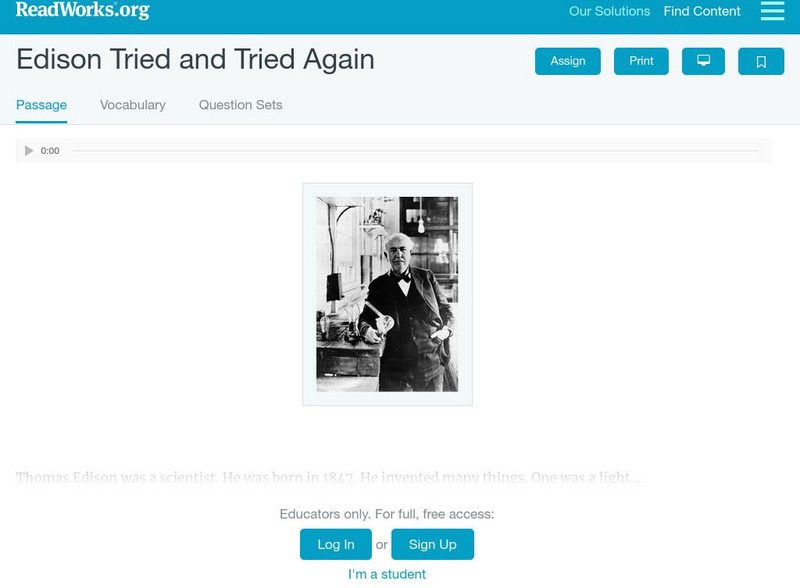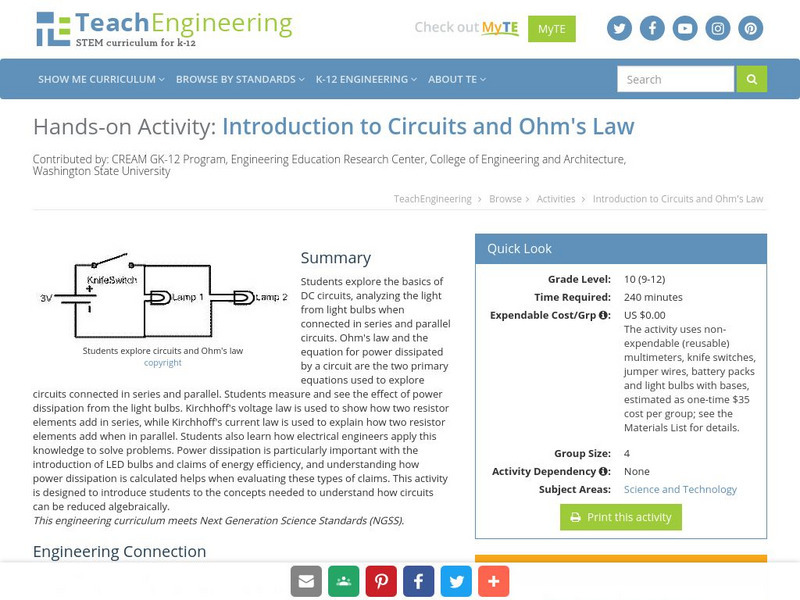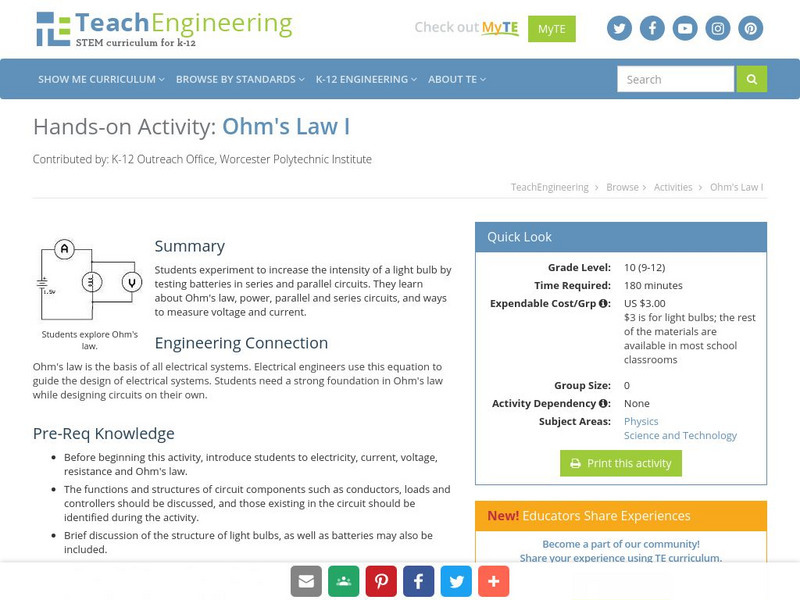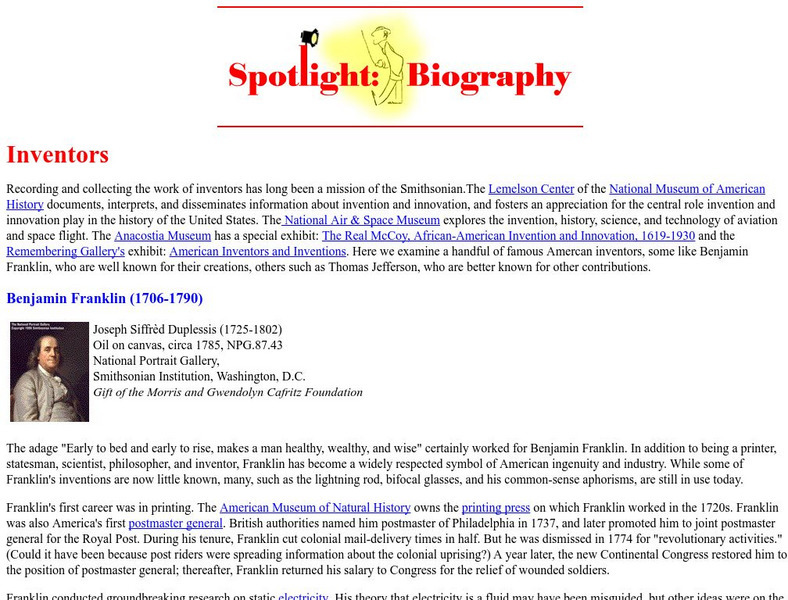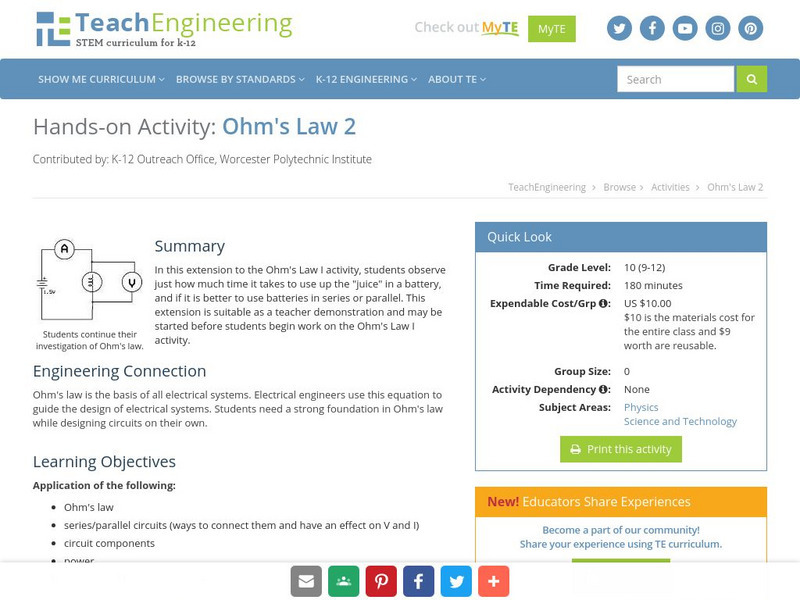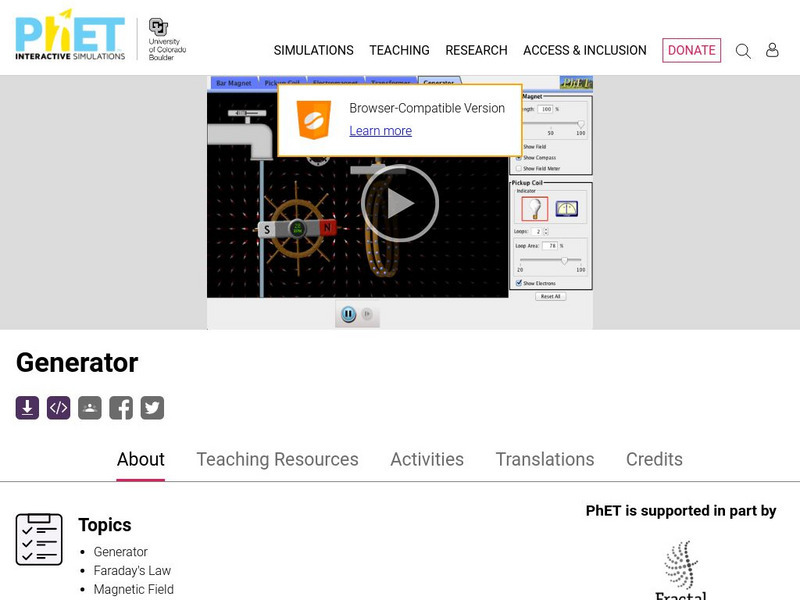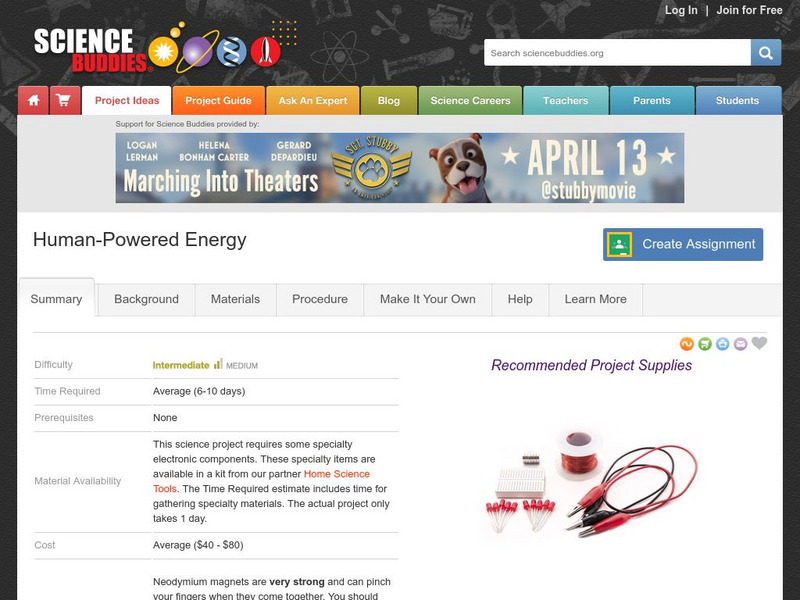Hi, what do you want to do?
Read Works
Read Works: Edison Tried and Tried Again
[Free Registration/Login Required] This biographical passage shares information about Thomas Edison, inventor of the light bulb. This passage is a stand-alone curricular piece that reinforces essential reading skills and strategies and...
University of Colorado
University of Colorado: Ph Et Interactive Simulations: Circuit Construction Kit (Dc Only)
An electronics kit in your computer! Build circuits with resistors, light bulbs, batteries, and switches. Take measurements with the realistic ammeter and voltmeter. View the circuit as a schematic diagram, or switch to a life-like view....
Florida State University
Florida State University: Magnet Lab: Electric Meter 1872
The invention of the light bulb quickly created the need to track people's electricity usage. In 1872, Samuel Gardiner built the first simple power meter: a lamp with an attached clock that recorded the time the light was on.
Curated OER
National Park Service: Thomas Edison National Historical Park: Thomas Edison
This site includes information about Thomas Edison's inventions and his home and family life. Find a lengthy biography and several sounds from Edison's original phonograph.
TeachEngineering
Teach Engineering: Introduction to Circuits and Ohm's Law
Students will explore the basics of dc circuits analyzing the light from light bulbs when connected in series and parallel circuits. Ohm's Law and the equation for power dissipated by a circuit will be the primary equations used. Using...
TeachEngineering
Teach Engineering: Saltwater Circuit
Students build a saltwater circuit, which is an electrical circuit that uses saltwater as part of the circuit. Students investigate the conductivity of saltwater, and develop an understanding of how the amount of salt in a solution...
TeachEngineering
Teach Engineering: Conductivity
Students make a simple conductivity tester using a battery and light bulb. They learn the difference between conductors and insulators of electrical energy as they test a variety of materials for their ability to conduct electricity.
TeachEngineering
Teach Engineering: Ohm's Law I
Students will work to increase the intensity of a light bulb by testing batteries in series and parallel circuits. It analyzes Ohm's Law, power, parallel and series circuits, and ways to measure voltage and current.
Other
Earliest Voices: Thomas Edison
This resource offers historic voice recordings of Thomas Edison. There is a recording of animal sounds, and a speech given at an electrical exhibition in 1908. A biography and downloadable images of him are also included.
Famous Scientists
Famous Scientists: Thomas Alva Edison
Meet the inventor of the phonograph, the motion picture camera, and the long-lasting, practical electric light bulb, Thomas Edison.
Library of Congress
Loc: Learning Page: Thomas Edison
This resource provides lesson plans and information about Thomas Edison and his inventions.
Smithsonian Institution
Smithsonian Education: Spotlight Biography Inventors
This site provides information on American inventors Benjamin Franklin, Robert Fulton, Eli Whitney, Thomas Jefferson, Isaac Singer, Wilbur Wright, Thomas Alva Edison, Elias Howe, and Alexander Graham Bell. It offers pictures from and...
TryEngineering
Try Engineering: Series and Parallel Circuits
The core of this lesson is simple circuits and the differences between parallel and series circuit design. Students perform experiments to test the differences between the two circuit designs using low voltage light bulbs.
Digital Public Library of America
Dpla: Electrifying America
This primary source set explores the development, commercialization, and impact of electricity.
Smithsonian Institution
Lemelson Center: Invention Features: Lewis Latimer
Smithsonian site features the life and many accomplishments of Lewis Latimer, the famous African-American inventor.
Science Struck
Science Struck: Facts About Thomas Edison
Read about the life of Thomas Edison and his many inventions.
Massachusetts Institute of Technology
Mit: Invention of the Week: Thomas Alva Edison
As the inventor of the lightbulb, phonograph, and the printing telegraph, Thomas Alva Edison (1847-1931), improved the daily lives of everyday people.
TeachEngineering
Teach Engineering: Ohm's Law 2
This extension to the Ohm's Law I activity, students will observe just how much time it takes to use up the "juice" in a battery, and if it is better to use batteries in series or parallel.
Library of Congress
Loc: America's Story: Thomas Alva Edison
A variety of images, photographs, and information on the life of Thomas Alva Edison (1847-1931) can be found in the site by the Library of Congress. Information can be found here regarding his invention and influence on American society....
University of Colorado
University of Colorado: Ph Et Interactive Simulations: Generator
Generate electricity with a bar magnet! Discover the physics behind the phenomena by exploring magnets and how you can use them to make a bulb light. Java required.
Science Buddies
Science Buddies: Shaking Up Some Energy
Shake N' Light flashlights have been advertised on televisions across the nation in the recent year. But many do not understand just how they get energy to light up the bulb without using batteries. Do this experiment to make your own...
National High Magnetic Field Laboratory
Magnet Academy: Fluorescent Lamp 1934
Compared to incandescent lamps, fluorescent lamps last longer, require less energy and produce less heat, advantages resulting from the different way in which they generate light.
Science Struck
Science Struck: Lemon Battery Experiment
In this step-by-step experiment, you will learn how to make a battery using four lemons and use it to light an LED bulb.
Curated OER
Educational Technology Clearinghouse: Clip Art Etc: Thomas Alva Edison
Thomas Alva Edison (February 11, 1847 - October 18, 1931) was an American inventor and businessman who developed many devices that greatly influenced life around the world, including the phonograph and the long-lasting, practical...





